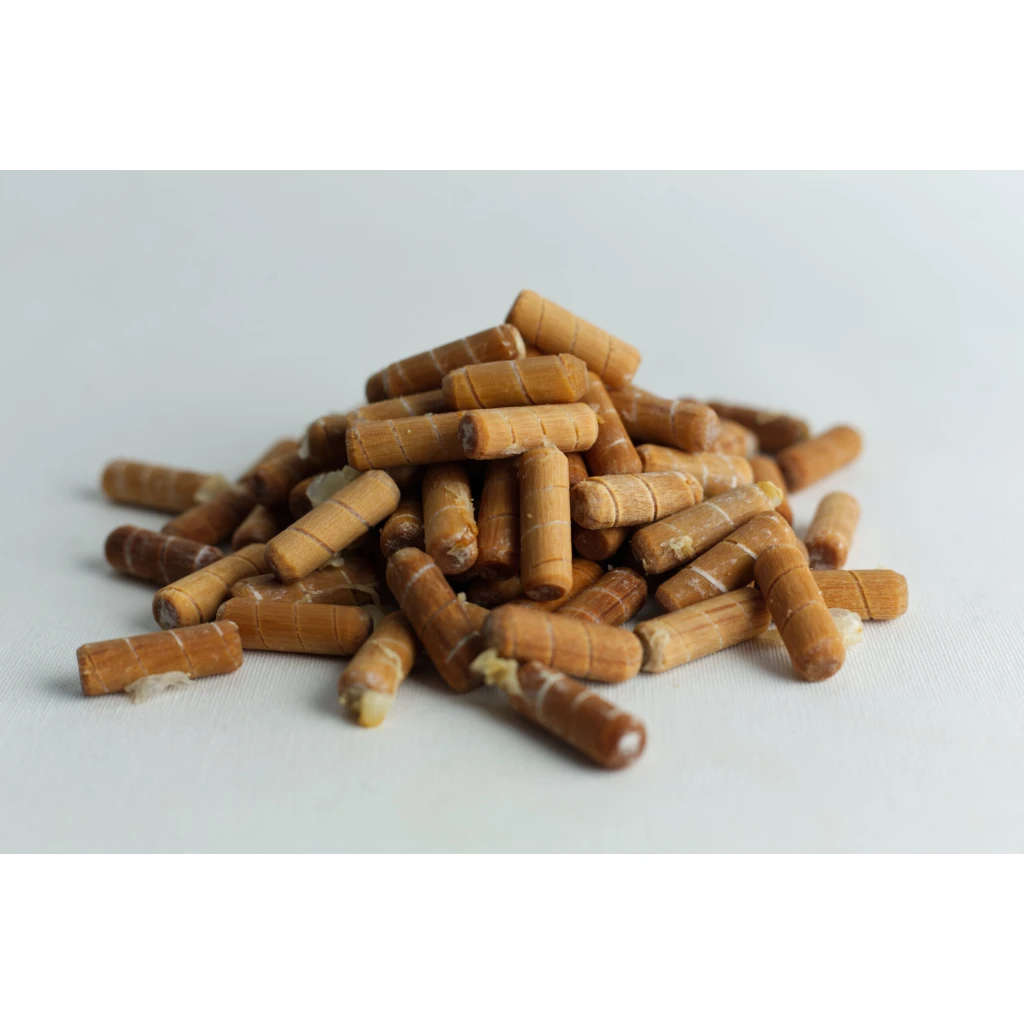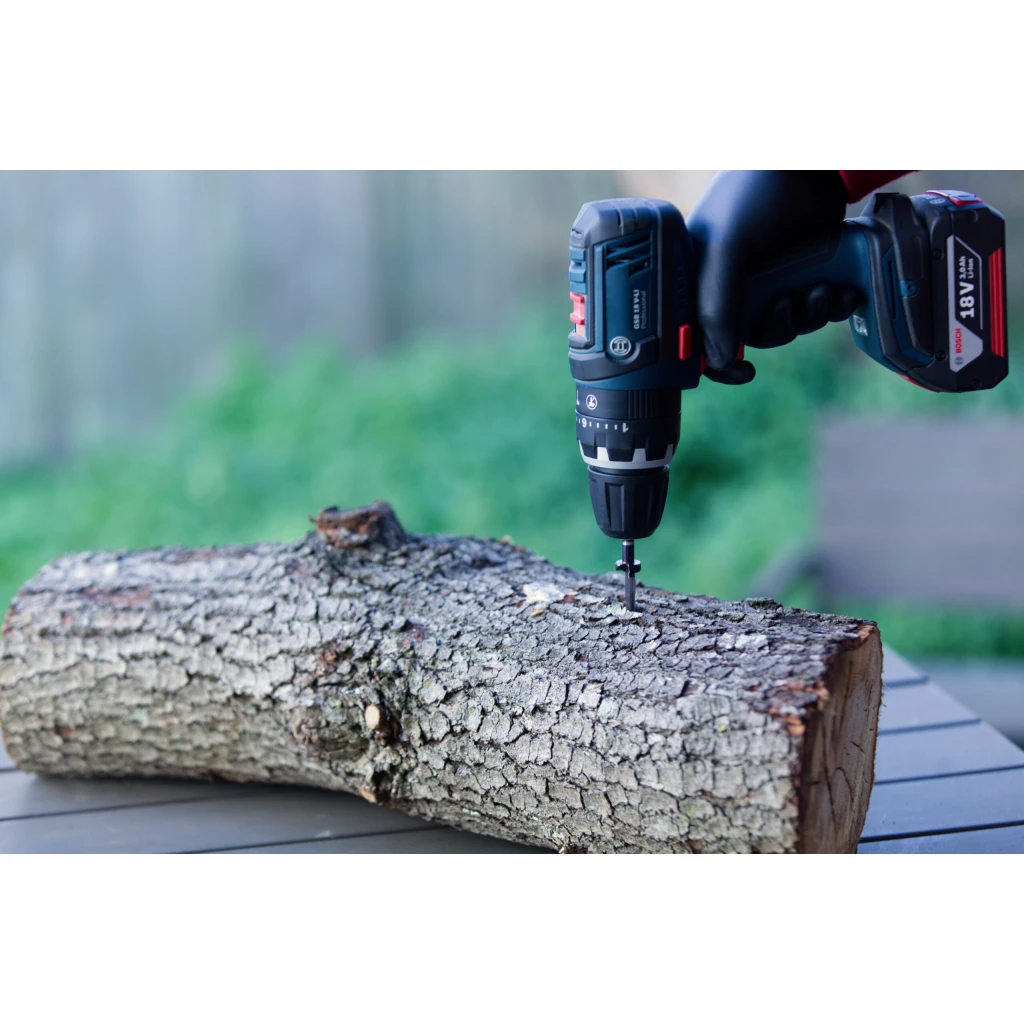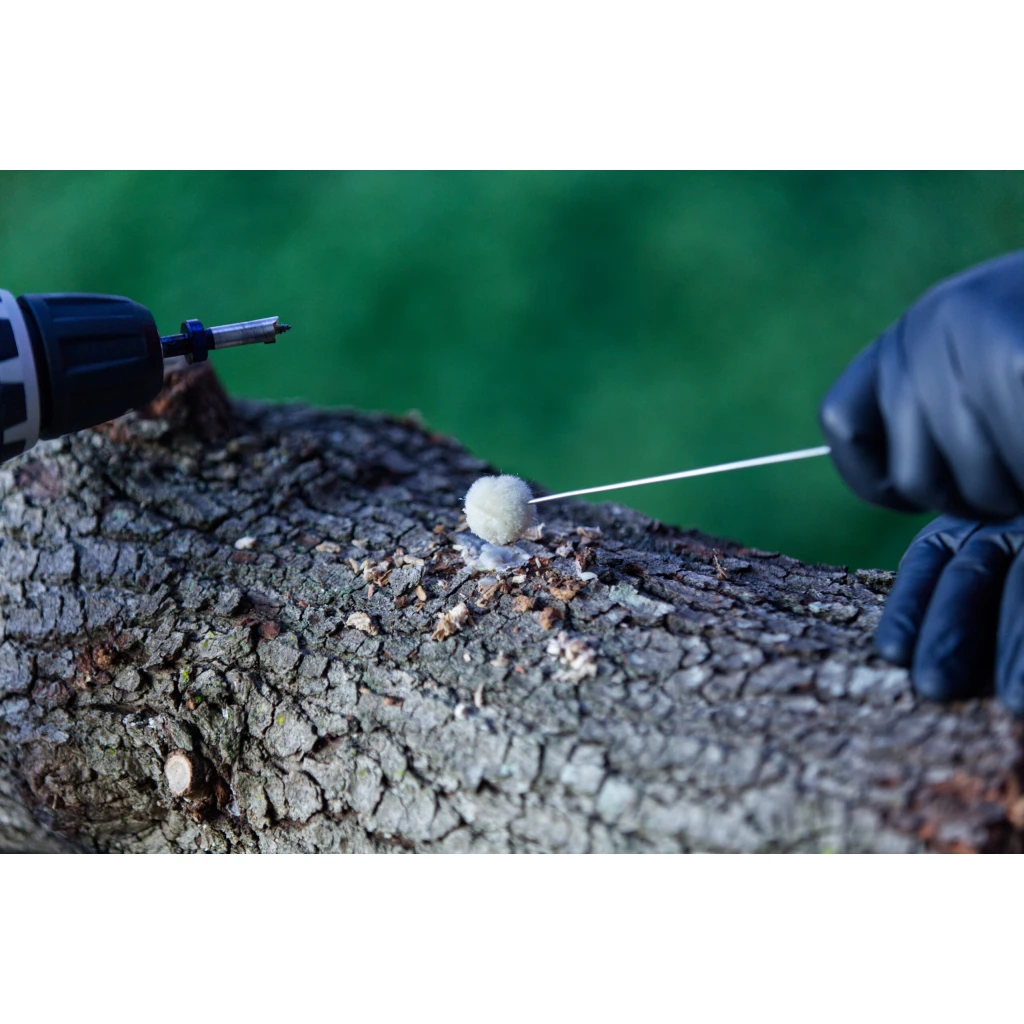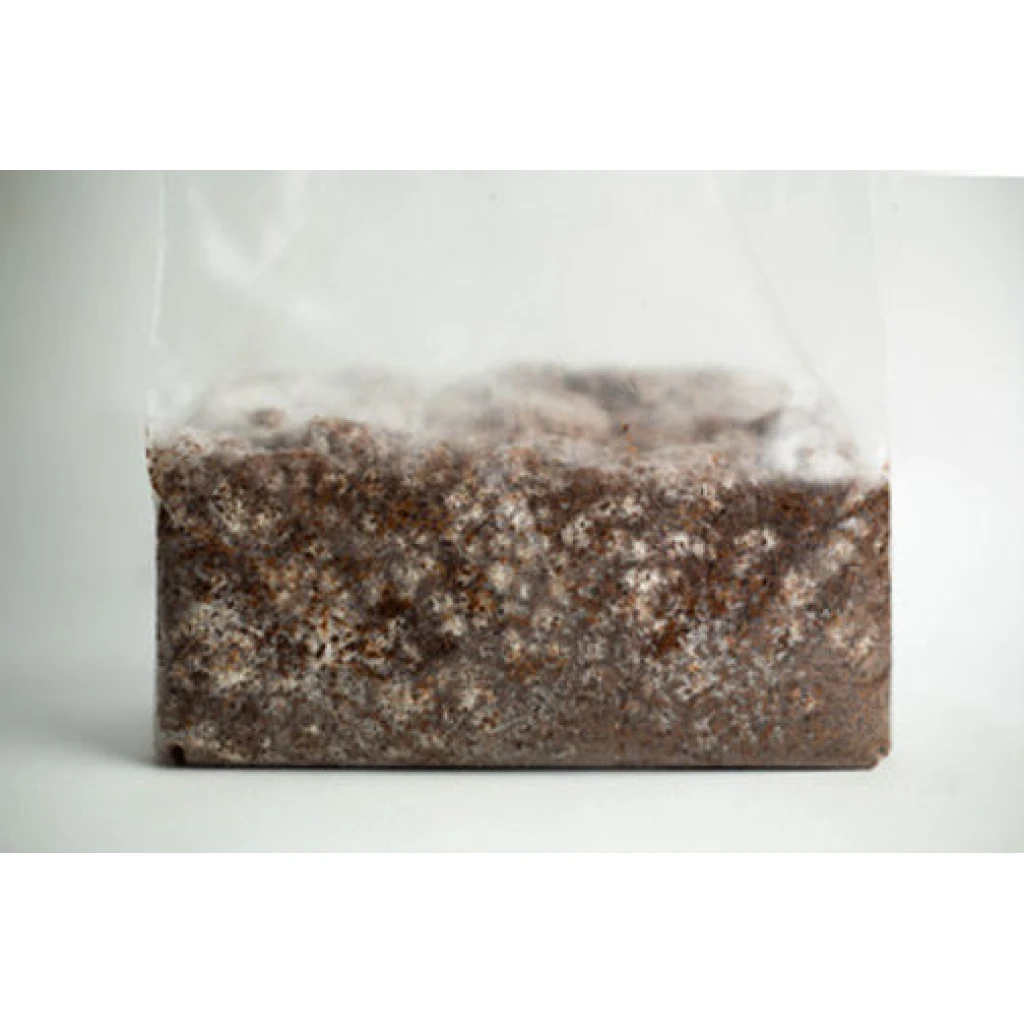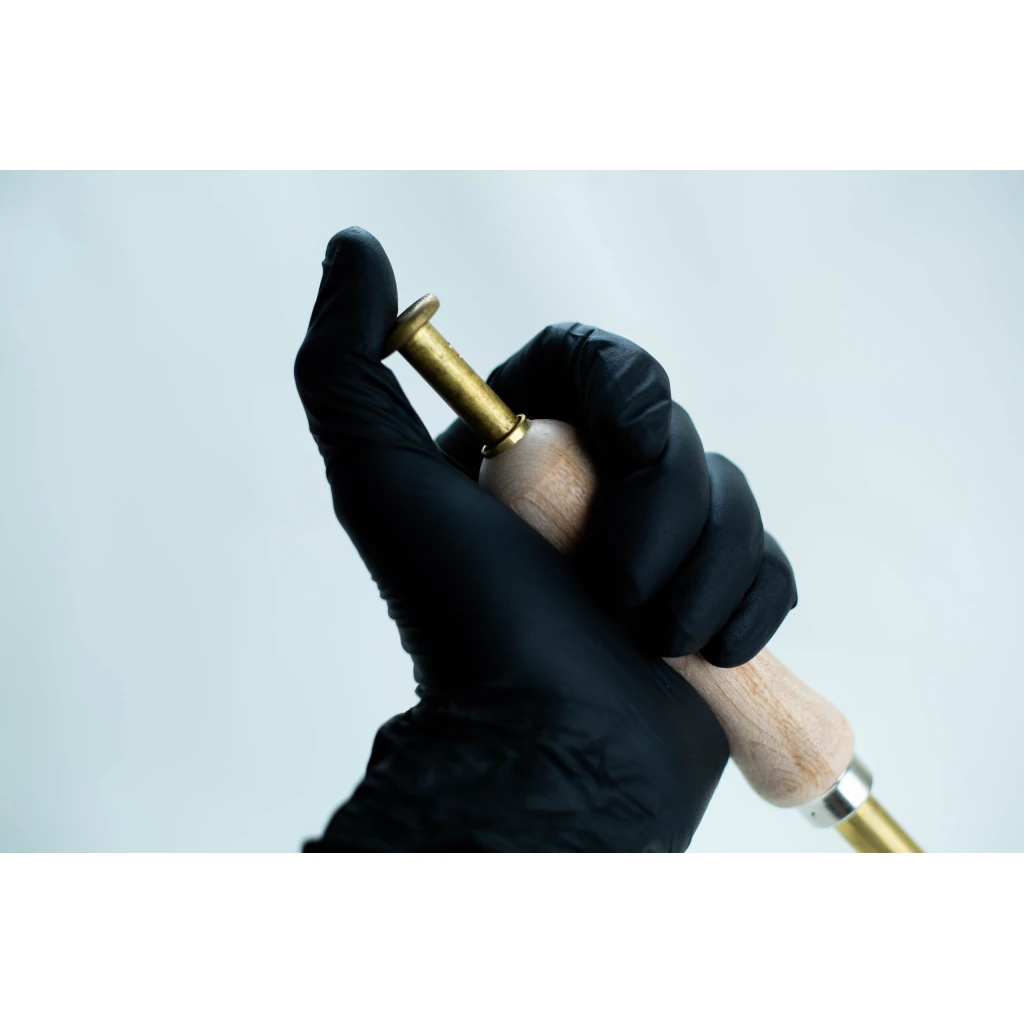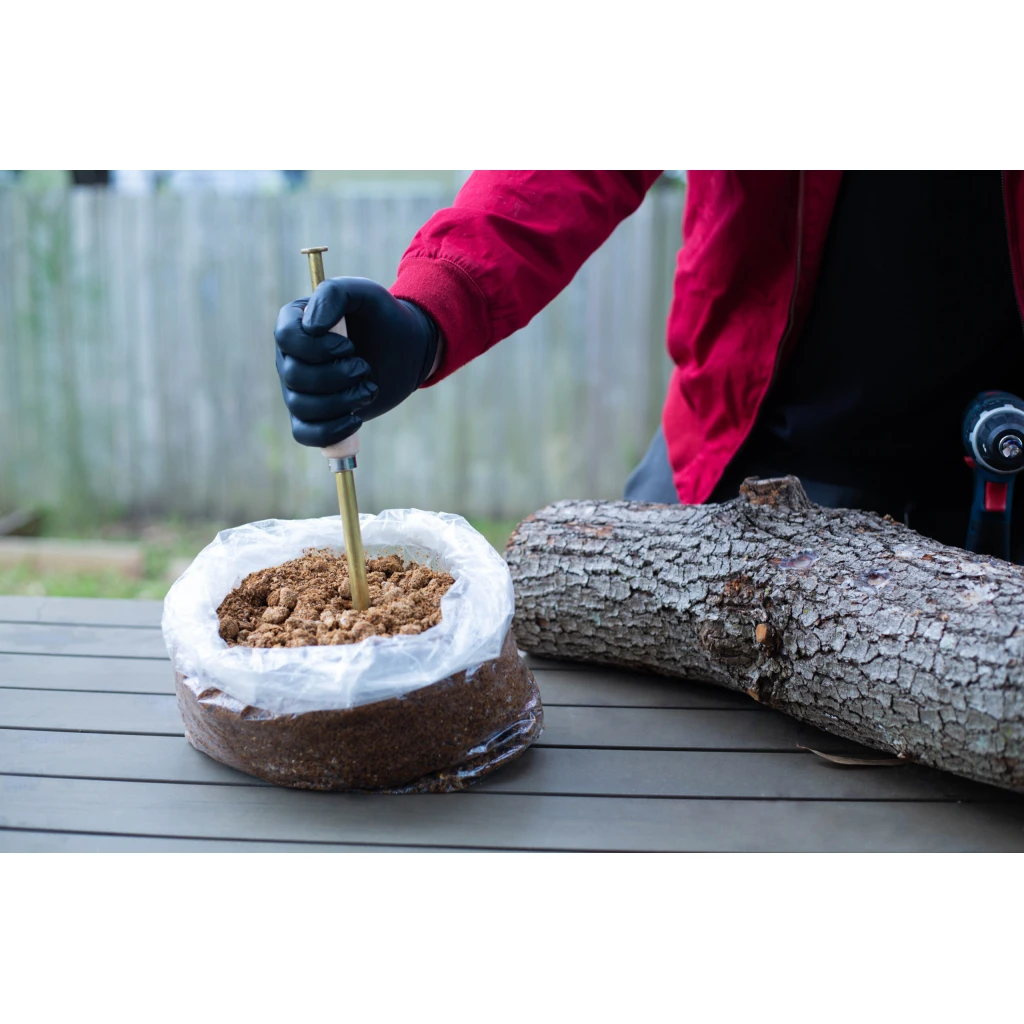Growing mushrooms on logs is a fulfilling and eco-friendly method for cultivating fungi, offering both environmental benefits and a fresh supply of mushrooms. This guide provides a comprehensive overview of the entire process, from choosing the right logs to harvesting your mushrooms, ensuring a successful cultivation experience. The article also covers selecting suitable tree species, what to look out for, necessary equipment, and instructions on making your own dowels if you have access to a sterilizer. We will explore two methods for inoculating your logs, each requiring different equipment.
Method 1: Using Dowels – Best for small quantities of logs
• Colonized hardwood dowels
• Spiral grooved design to protect mycelium during log insertion
• Prepared in high-quality cleanrooms and laboratory facilities
• Sealed in a filter patch bag to breathe and store for up to 2-3 months if not used immediately
• Required equipment: Log dowel inoculation kit or drill bit 8.5mm only, dauber only, beeswax only,drill bit angle grinder adapter (optional)
Method 2: Using Sawdust Spawn
• 3 kg sawdust in various options
• Prepared in high-quality cleanrooms and laboratory facilities
• Sealed in a filter patch bag to breathe and store for up to 2 months if not used immediately
• Required equipment: Sawdust log inoculation kit, sawdust tool only, 12.5mm drill bit only, dauber only, beeswax only.
Distinction between Hardwood and Softwood trees
Before we go in-depth, it is important to know that the distinction between hardwoods and softwoods isn’t based on the actual hardness of the wood; some hardwoods are softer than many softwoods. Instead, the classification is based on the botanical characteristics of the trees.
Suitable Wood Types for growing mushrooms on logs
Broad-leaved trees (hardwoods, angiosperms) are preferred over softwoods (gymnosperms). Hardwood and softwood trees differ significantly in their biological characteristics and suitability for mushroom cultivation.
Hardwood Trees (Angiosperms)
Hardwood trees, also known as angiosperms, produce seeds enclosed within fruits and have broad leaves. They are typically deciduous, shedding their leaves annually. Hardwoods grow more slowly than softwoods, resulting in denser, more durable wood. This category includes species like oak, beech, birch, maple, and alder. Role in Mushroom Cultivation Hardwoods are generally preferred for mushroom cultivation. The high lignin content in hardwoods makes them more susceptible to breakdown by mushroom mycelium, providing essential nutrients for growth. This leads to better yields and potentially enhances the flavor of the mushrooms.
Hardwood Varieties That Are Soft Hardwood:
- Balsa (Ochroma pyramidale): A very soft hardwood, though not native to Australia.
- Cottonwood (Populus deltoides): Lightweight and soft.
- Willow (Salix spp.): Soft and light, used in products like cricket bats.
- Aspen (Populus tremuloides): Soft hardwood used in making matches and paper.
- Silver Wattle (Acacia dealbata): A relatively soft Australian native hardwood.
- Blackwood (Acacia melanoxylon): Softer than many other Australian hardwoods.
- Basswood (Tilia americana): A soft hardwood, not native to Australia.
- Poplar (Populus spp.): A soft hardwood.
- Corkwood (Duboisia myoporoides): Known for its light and soft wood, used in various applications.
Soft hardwood trees like willow, poplar, basswood, and silver wattle can be used for growing mushrooms, but oysters are recommended due to their lesser nutritional demands compared to other varieties.
Softwood Trees (Gymnosperms)
Softwood trees are gymnosperms, meaning they produce seeds without an enclosing fruit, often in cones. These trees are typically evergreen, retaining their leaves year-round. Softwoods like pine, cedar, and redwood grow faster and are less dense than hardwoods. Challenges in Mushroom Cultivation Softwoods are generally less suitable for mushroom cultivation due to their lower lignin content and anti-rotting compounds, which can inhibit mycelium growth. These compounds reduce nutrient absorption efficiency, leading to slower colonization and lower yields. However, certain techniques, like conditioning (soaking and boiling) or blending softwoods with hardwoods, can enhance their suitability for mushroom growth. In summary, while both hardwoods and softwoods can be used for mushroom cultivation, hardwoods are typically more effective due to their composition and structure.
Components of Tree Structure
Bark, Sapwood, and heartwood are essential components of a tree’s structure, each serving distinct functions.
• Bark is the outermost layer of a tree, protecting against environmental threats such as moisture loss, temperature extremes, and pests. It consists of both the outer bark, which is made up of dead cells, and the inner bark, or phloem, which is responsible for transporting nutrients throughout the tree.
• Sapwood is the living, outermost layer of wood beneath the bark. It plays a crucial role in the tree’s physiology by conducting water and nutrients from the roots to the leaves. Sapwood is typically lighter in color and contains living cells that help in the storage and transport of energy reserves.
• Heartwood is the central, non-living part of the tree trunk. As the tree ages, the inner sapwood cells die and transform into heartwood, which provides structural support. Heartwood is often darker due to the accumulation of chemical compounds that make it more resistant to decay and insect attacks.
Log Selection and Preparation
• Hardwoods only: Oak, eucalyptus, beech, chestnut, wattle, maple, hickory, sweet gum, sycamore, alder, birch
• Avoid ironbark, camphor laurel, anti-rot varieties, and softwoods (e.g., pine, bottlebrush) or aromatic wood varieties.
• Avoid monocots like palm; they are neither hardwood nor softwood.
• Fruit trees are not the best producers of mushrooms.
• Avoid branches as they lack sufficient diameter, dry out quickly, and won’t produce much.
• Shiitake and other species like sapwood, not heartwood. Logs with substantial amounts of sapwood are ideal for shiitake or any other variety. Species like chicken of the woods and reishi can also digest heartwood.
• If using eucalyptus species or gums, they often shed bark during summer, so it’s best to wait until after this time. Eucalyptus spp. are best for growing shiitake.
• Small-diameter wood will colonize more quickly but will not produce for as many years and can dry out. Larger logs are heavy and hard to work with.
• Inoculate logs within a week or two of cutting them, allowing enough time for some antifungal properties in the wood to dissipate but not too long for the wood to dry out or other competitor fungi to take up residence.
• The best time to harvest is after winter in spring; autumn is also fine.
• Having bark on the wood is fine as it can protect from moisture loss, especially if you are living in a dry arid region.
Ideal Log Dimensions
• Diameter: 10-15 cm
• Length: 60-100 cm
Wood Condition
• Use freshly cut logs (within 2 weeks of felling) or as soon as possible.
• Older logs are fine but may dry out or get inhabited by competing fungi.
• Cut logs from healthy, living trees during the dormant season if possible. The dormant season ensures the tree has collected enough sugars to survive, which helps with an abundant mushroom harvest.
Inoculation Process – Dowel Technique
- Drill Holes
o Use our dowel drill bit 8.5 cm with a stopper.
o Create holes 5 cm apart in rows.
o Stagger rows in a diamond pattern.
o Keep a distance of at least 2.5 cm from log ends. - Insert Plug Spawn
o Place dowel in the hole and use a mallet to insert it. - Seal with Wax
o Use food-grade paraffin, beeswax, cheese wax, or soy wax.
o Cover inoculation sites and log ends (optional). Log ends are recommended if you live in a particularly dry region and the log size is large enough to make it worthwhile.
o Caution: Melted wax is flammable; follow safety precautions.
Quantity Recommendation Use 50 plugs for a log 10-15 cm wide and 100 cm long. More dowels mean faster colonization.
Inoculation Process – Using Sawdust
- Drill Holes
o Use our Sawdust drill bit 12.5 with a stopper.
o Create holes 5 cm apart in rows.
o Stagger rows in a diamond pattern.
o Keep a distance of at least 2.5 cm from log ends. - Prepare and Insert Sawdust Spawn
o Loosen the sawdust: Begin by loosening the sawdust spawn in its original bag or transferring some to a container if you are not using the whole bag at once.
o Load the Inoculation Tool: To fill the tool, repeatedly press it into the loose sawdust spawn until the chamber is full.
o Inoculate the Log: Align the tip of the tool with the pre-drilled hole in the log. Gently press down on the top of the tool to release the spawn into the hole. Add more spawn or remove excess if needed. - Seal with Wax
• Use food-grade paraffin, beeswax, cheese wax, or soy wax.
• Cover inoculation sites and log ends (optional). Log ends are recommended if you live in an arid region and the log size is large enough to make it worthwhile.
• Caution: Melted wax is flammable; follow safety precautions.
Post-Inoculation Care : Colonization
• Colonization duration: 6 months to 2 years, depending on species.
• Keep logs consistently moist; water regularly to support mycelium growth.
• Keep logs protected from sun and pests and wildlife.
Fruiting
• Begins when environmental conditions are suitable (temperature and humidity).
• Production lasts 3.5 to 7+ years, depending on variety, diameter of logs, length, watering, and temperature.
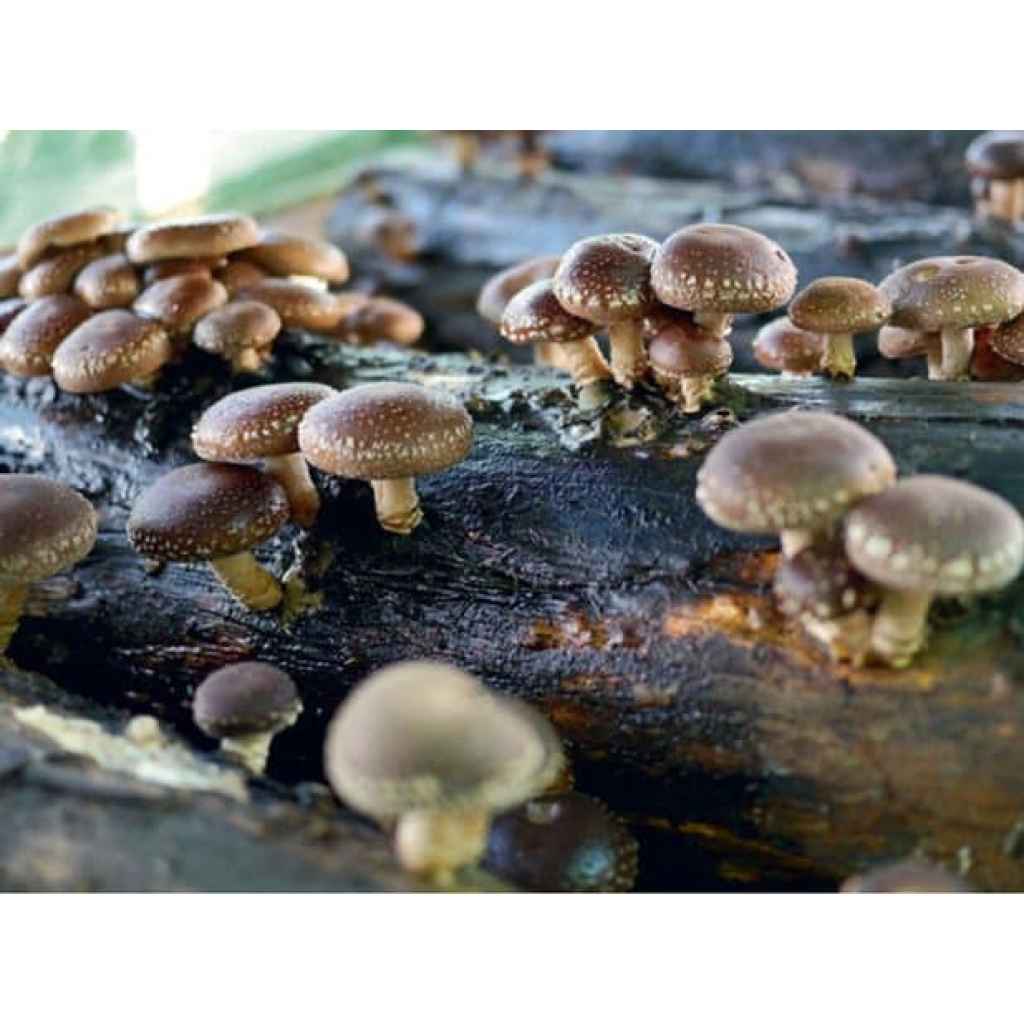
Harvest
• Properly identify mushrooms before consuming.
• Label each log with the variety inoculated and the date; this is essential and needs to be weather-resistant.
• Twist the entire cluster off the log for varieties like oysters that grow on logs.
• Harvest when the cap bends downwards; when they move upwards, the shelf life decreases drastically, they sporulate, and it affects texture, flavor, and susceptibility to wildlife damage.
Maintenance
• Maintain log moisture through regular watering or soaking and provide shade. Use our log blanket to protect from pests and sun.
Storage and Handling Unused Plug Spawn
• Store in the refrigerator, except for pink oyster and wood ear, which are cold-sensitive varieties that should be used immediately.
• Viable for 2-3 months when refrigerated; best if used within 2 months. Use our bag sealing clip to reseal the bag or use a heat sealer.
By following these detailed instructions, you can successfully inoculate logs with dowel plug spawn or sawdust and cultivate your chosen mushroom species. Maintain proper hygiene and follow safety precautions throughout the process. If you are unsure, contact us for guidance on specific log varieties.
Additional Information and Tips
• It is recommended to have a few logs with varying fruiting temperatures to get mushrooms year-round. Grow blue pearl oysters and lion’s mane in spring, winter, and autumn, and grow pink and yellow oyster and warm white oysters in summer.
• Remember, fruiting is not the same as inoculation (introducing the fungi to the logs). You can inoculate at any time of the year. Generally, they are inoculated after winter when you actually chop a tree down.
• You can inoculate all types of species at the same time, but they will fruit when the temperatures are favourable to them.
• Eucalyptus spp. is readily available in Australia and is recommended for use. Some people may experience stomach upset due to eucalyptus oils, but this is very rare. The majority of people are fine. Initially, only consume mushrooms in small quantities from eucalyptus logs, and if you do not notice discomfort, you can increase the quantity.
• More information is available in the FAQ section.
• Some articles online suggest that the wood needs to be cured for a few weeks before use, but this can be misleading. Use the logs as soon as possible. Keeping logs for a few weeks has some advantages like the dissipation of some anti-rot chemicals found on trees naturally, but waiting can also give time for competing fungi to start colonizing the log. If you do wish to wait or have no option but to wait, store the wood above ground after they have been chopped and cover them to minimize any competing fungi from getting into the logs.
• You can also grow mushrooms on stumps and decompose stumps naturally. More information is in the FAQ section.
• If your tree is still standing in the ground and is dead, do not inoculate it. We should never inoculate a diseased tree or dead tree that you do not know when it died, as they will have a lot of competing organisms that will prohibit the growth of mushrooms. It is best to chop the tree down to a manageable size before inoculating as they need to be stored away from the sun.
• Reishi mycelium gets really hard, it’s recommended to use them as soon as possible.
• Pink oysters and wood ears are cold-sensitive species and should not be grown in areas that get extremely low temperatures; if they do, please protect them by taking them indoors in cooler months.
• If you have access to acreage with lots of logs, growing mushrooms on logs is recommended. We receive many inquiries from people in cities wanting to grow on logs. This is fine, but it is important to understand that there are other ways of growing mushrooms, such as in buckets and bags, for people in urban areas. If you want to learn, contact an arborist in your area and ask for logs.
• Not all mushrooms can be grown on logs, only the wood-loving variety. All the dowel plug spawns we sell are wood-loving varieties. Some sawdust spawn we sell like wood blewits, wine caps, and morels can’t be grown on logs. There are people online who also sell dowels for varieties like wine caps. They use dowels because grain spawn gets eaten by birds, but dowels do not, ensuring mycelium has time to establish. We sell sawdust spawn for this reason, as unlike grain spawn, it does not get eaten by wildlife and is 10 times more efficient than dowels.
• Some logs are better than others for certain varieties. We do not have educational material on all tree species as there are so many, but experimenting is the best way to go. Don’t be afraid to try a wide range of species or ones not listed. There are still many combinations to be tried and learned from! You could get varying results in yield, but you may be surprised by the resilience of the fungi kingdom.
• Anti-rot trees: There are many tree varieties with antifungal properties that are resistant to fungi. It is best to check online for the tree species you have to ensure they are not anti-rot varieties. It is recommended to use trees that are not sprayed with pesticides and are sustainably harvested.
• Certain oyster mushrooms will grow on pine, but the yield will be very low.
• Some varieties react (fruit) to the sound of thunder or even when shocked by dropping them from a height, which can sometimes activate mushroom growth.
• We also sell unicolated dowels to grow mushrooms. Boil the dowels in a pot making sure you only fill less than half of the pot with water. Dowels will release some sap and water will get cloudy. You can change the water if it gets difficult to work with. When all dowels sink in the water is when you know they are hydrated and ready to be sterilized. Sterilize in a pressure cooker for 1.5 hours in a breathable mushroom bag. Once they cool down, use our grain spawn to inoculate the dowels. The most convenient option is to get multiple 100g packs. Do not inoculate dowels with liquid culture.
FAQs
What are some good eucalyptus trees to grow mushrooms on?
• Mountain Ash: Eucalyptus regnans
• Tasmanian Blue Gum: Eucalyptus globulus
• Grey Gum: Eucalyptus major or Eucalyptus propinqua
• Snow Gum: Eucalyptus pauciflor
• Messmate: Eucalyptus obliqua• Yellow Box: Eucalyptus melliodora
• Rose Gum: Eucalyptus grandis (also known as Flooded Gum)
• Shining Gum: Eucalyptus nitens
Why are Maitakes not growing on logs for me?
Maitakes are a bit different, we suggest to grow them only on oaks and to treat the log by either boiling or steaming before inoculation.
I live in a city, how do I get access to the logs?
Contact an Arborist. Arborists are people who chop down trees for a living. They can provide you with access to logs suitable for mushroom cultivation.
There is another option ie to use 'Ekologs'. Make sure its not coir but hardwood sawdust kind.
It is important to know, the log method of growing mushrooms are popular with people with property or abundance of logs, for city dwellers, you can look at growing mushrooms in buckets or bags.
How long does it take for the mushrooms to start fruiting after inoculation?
The colonization process typically takes between 6 months to 2 years, depending on the mushroom species and environmental conditions. Fruiting occurs when the logs are fully colonized and environmental factors such as temperature and humidity are favorable.
What type of wood is best for growing mushrooms on logs?
Hardwoods, such as oak, beech, birch, maple, and alder, are generally preferred for mushroom cultivation due to their high lignin content, which provides essential nutrients for mushroom growth. However, some softwoods like poplar and willow can also be used, particularly for species like oyster mushrooms.
How many dowels do I need for one log?
For a log that is 10-15 cm in diameter and 100 cm in length, you will need about 50 dowels.
Can I use logs from trees that were cut a while ago?
It's best to use freshly cut logs (within 2 weeks of felling) for inoculation. Older logs can still be used, but they may have dried out or become inhabited by competing fungi, which could affect the success of the inoculation.
How should I care for the logs after inoculation?
Keep the logs consistently moist by watering them regularly. You can also soak them periodically to maintain moisture levels. Ensure the logs are placed in a shaded area to protect them from direct sunlight and drying out.
What is the shelf life of unused plug spawn?
Unused plug spawns should be stored in the refrigerator and are viable for 2-3 months. For optimal results, it's best to use them within 2 months. Note that pink oyster and wood ear varieties are cold-sensitive and should be used immediately instead of being stored in the refrigerator.If you do, however, choose to store them in the fridge, do so above 10°C.
When is the best time to harvest mushrooms?
Harvest mushrooms when their caps are slightly flattened; this is when they are at their best texture and flavour. If the caps have started to upturn, the mushrooms are likely overripe, which can affect their quality. They will also sporulate a soon as the cap turns upwards.
Can I inoculate logs at any time of the year?
Yes, you can inoculate logs at any time of the year, but generally speaking, you will inoculate them when you chop down a tree, which is often in spring.
What precautions should I take during the inoculation process?
Ensure you follow safety guidelines when handling tools and melted wax, as it is flammable. Also, be mindful of maintaining a clean environment to avoid contamination by unwanted fungi.
Is there any way to protect the logs from pests?
What are some of the best trees to grow Lion's Mane on?
Lion's Mane mushrooms (Hericium erinaceus) grow best on certain hardwoods like oak, beech, and maple. They can also thrive on chestnut, hornbeam, sweetgum, sycamore, walnut, and birch for several reasons:
- Nutrient Content: These hardwoods provide the right balance of lignin and cellulose, which are essential for the mushrooms to grow. The breakdown of these components supports the mushroom's development.
- Natural Habitat Mimicry: In the wild, Lion's Mane mushrooms naturally grow on hardwood trees like oak, beech, and maple. Using these woods for cultivation helps replicate their natural environment, promoting successful growth.
- Durability and Decomposition Rate: Hardwoods like oak and maple decompose at a rate that matches the growth cycle of Lion's Mane. This slow decomposition provides a steady release of nutrients, supporting multiple batches of mushrooms over time.
- Resistance to Contaminants: These hardwoods are less likely to harbor contaminants compared to softer woods, reducing the risk of competing fungi and bacteria that could hinder mushroom growth.
Are willows hardwoods, and are they good for growing mushrooms?
Yes, willow is technically a hardwood because it comes from a broadleaf, deciduous tree. However, willow is lightweight and relatively soft. It has low strength properties and is often softer than many other hardwoods and even some softwoods. Despite being classified as hardwood, willow is less durable than other hardwoods. While willow can support the growth of mushrooms like oyster and shiitake, there are better options.
Why is willow considered a soft hardwood when cricket bats, which are so strong, are made from it?
Cricket bats are traditionally made from willow wood, specifically from a type known as cricket bat willow (Salix alba var. caerulea). Willow is chosen for cricket bats because of several key properties:
- Lightweight: Willow is relatively lightweight, allowing players to swing the bat with speed and control, which is important for both defensive and offensive play in cricket.
- Strength and Flexibility: Willow combines strength with flexibility, helping absorb the impact of the ball while maintaining the bat's structure. This balance allows for powerful shots without the bat breaking easily.
- Springiness: Willow is known for its "springy" nature, which contributes to a better "sweet spot" on the bat. This quality enhances performance by providing a good rebound effect when the ball strikes it.
- Durability: Despite being softer than many other hardwoods, willow is resilient to repeated impacts from a cricket ball, which is essential for the bat's longevity.
What trees in Australia are not suitable for growing mushrooms?
When considering woods that are unsuitable for mushroom cultivation, particularly in Australia, it is important to note that certain types of wood are generally not recommended due to their natural properties. Here are ten varieties of wood that are typically avoided for mushroom growing:
1. Pine (Pinus spp.): Pine is often avoided because it is too resinous and can inhibit mushroom growth
1. Cedar (Cedrus spp.): Known for its aromatic oils, cedar is generally not used for mushroom cultivation as these oils can be antifungal.
2. Redwood (Sequoia sempervirens): Similar to cedar, redwood contains natural chemicals that can inhibit fungal growth.
3. Cypress (Cupressus spp.): Cypress wood is naturally resistant to decay and can be too dense and resinous for mushrooms.
4. Spruce (Picea spp.): Like pine, spruce is a softwood that is generally not suitable for mushroom cultivation due to its resin content.
5. Fir (Abies spp.): Fir wood is another softwood with resinous properties that can inhibit mushroom growth.
6. Hemlock (Tsuga spp.): Hemlock is typically avoided because it shares similar properties with other resinous softwoods.
7. Teak (Tectona grandis): Although durable, teak is oily and dense, making it unsuitable for most mushroom cultivation.
8. Black Locust (Robinia pseudoacacia): This wood is very dense and rot-resistant, which can make it difficult for mushrooms to colonize.
Which Native trees in Australia are Anti-decay and best avoided for growing mushroom?
These woods are generally avoided in mushroom cultivation due to their natural resistance to decay, high resin or oil content, and other properties that inhibit fungal growth:
• Cypress Pine (Callitris columellaris): This species, also known as White Cypress Pine, is widespread in Australia, particularly in drier inland regions.
• Jarrah (Eucalyptus marginata): Jarrah is native to the southwest of Western Australia and is well-known for its durability and resistance to decay.
• Spotted Gum (Corymbia maculata): This tree is native to eastern Australia.
• Ironbark, particularly Australian species like Eucalyptus sideroxylon (Red Ironbark), Eucalyptus paniculata (Grey Ironbark), Eucalyptus crebra (Narrow-leaved Ironbark), Eucalyptus tricarpa (Red Ironbark), Eucalyptus drepanophylla (Grey Ironbark), and Eucalyptus taurina (Helidon Ironbark).
• Tallowwood (Eucalyptus microcorys): Found along the coastal regions of New South Wales and Queensland.
• Blackbutt (Eucalyptus pilularis): Native to eastern Australia.
• Red Mahogany (Eucalyptus resinifera): This species is found in coastal areas of eastern Australia.
• Grey Box (Eucalyptus moluccana): This hardwood is native to Australia.
• Turpentine (Syncarpia glomulifera): Found along the east coast of Australia.
• Forest Red Gum (Eucalyptus tereticornis): This species is widespread in eastern Australia.
How to Protect mushroom logs from termites?
To protect mushroom logs from termites, focus on strategies like elevating the logs using pallets or rocks to reduce soil contact, which is a common entry point for termites. Place the logs in a shaded area with good airflow to discourage termites, as they thrive in dark, damp environments. Use physical barriers such as mesh or netting to prevent termites and other pests from accessing the logs. Regularly inspect the logs for signs of termite activity, such as mud tubes or wood damage, and maintain dry conditions around the logs to prevent moisture accumulation, which attracts termites. There are some biological and chemical pest control methods as well.
Can you inoculate mushroom mycelium in living trees instead of logs?
Most cultivated mushrooms, like Oysters, are saprophytic, meaning they feed on dead wood rather than living trees.
Can you grow logs in all regions of Australia, including tropical and dry regions?
Mushroom logs can indeed be grown in various parts of Australia, including tropical and dry regions, with some considerations. The success of growing mushrooms on logs largely depends on the species of mushroom grown. In tropical regions, heat-tolerant species like pink and yellow oyster mushrooms, Reishi, and other tropical ecotypes can thrive, provided they have sufficient shade. In dry regions, maintaining moisture is crucial, so placing logs in shaded, cool areas and ensuring they are well-watered is important for successful cultivation. If the logs are watered well and have shade, most species can thrive. It is advisable to seal the end of the logs with wax in a dry region to minimize moisture loss and use thick and long logs as they can retain moisture for the longest without drying out. If your tree has bark, do not remove it as it can also aid in preventing moisture loss in dry regions.
Can you grow mushrooms in a paperbark log?
The paperbark tree, belonging to the genus Melaleuca, is native to Australia. It is characterized by its distinctive papery bark. While there is evidence of mushrooms growing on paperbark, it is not commonly listed as a preferred variety. Oyster species are best suited to grow as they are quite versatile and tolerant of various kinds of woods. Paperbark is considered a softwood.
Can Bottlebrush logs be used to grow mushrooms?
Most mushrooms suitable for log cultivation prefer hardwoods such as oak, maple, beech, and sweet gum. These woods provide the dense structure and nutrients that mushrooms need to thrive. Bottlebrush (Callistemon) trees, however, are not typically classified as hardwoods, making them less ideal for mushroom growth.
How much water is enough for mushroom cultivation on logs? Can you overwater?
When logs are stored outdoors under a tree, natural rainfall is often sufficient to maintain adequate moisture in some regions. However, in areas with intense sunlight and hot summers, logs may dry out more quickly and require more frequent watering. Periodic deep watering is generally more effective than frequent light watering. You can soak the logs in water for a day or hose them down for 10-15 minutes weekly or every few weeks. If you notice the logs starting to shrivel, it's a clear sign they need more moisture to prevent further drying. Perfecting the watering balance comes with experience and practice. Fortunately, most mushroom species are forgiving; if you forget to water, simply do so when you notice they have shriveled. Logs will only absorb as much water as they need, so overwatering isn't a major concern. However, it's crucial not to keep the surrounding area constantly moist or waterlogged, as excessive moisture can hinder mushroom growth.
Can I grow all types of mushrooms in Eucalyptus trees?
Shiitake mushrooms are recommended for growth on eucalyptus logs primarily because eucalyptus provides a suitable substrate for the fungi without significant negative effects from the wood's natural oils, although it will support all mushroom varieties. Eating mushrooms grown on eucalyptus logs can have some specific effects, particularly related to the sensory qualities of the mushrooms, but generally does not pose significant health risks. Here are some key points regarding the effects:
Flavor and Texture: Mushrooms grown on eucalyptus substrates may exhibit changes in flavor, becoming more "mushroomy" with a slightly altered texture. Studies have shown that the use of eucalyptus mulch can affect the sensory qualities of mushrooms, such as taste and texture, making them more spongy and potentially more acidic.
Color: There may be slight changes in the color of the mushrooms grown on eucalyptus, often resulting in a more intense brown hue.
Health and Safety Considerations:
Oil Content: While eucalyptus wood contains natural oils, these do not typically transfer to the mushrooms in significant amounts that would cause health concerns. Shiitake mushrooms, in particular, are known to grow well on eucalyptus logs without absorbing harmful levels of these oils.
Potential Allergic Reactions: As with any food product, individuals with specific allergies or sensitivities should exercise caution. However, there is no specific evidence to suggest that mushrooms grown on eucalyptus logs pose additional allergy risks compared to those grown on other hardwoods.
Can we add mushroom liquid culture on logs to grow mushrooms?
The log will soak up the water, leaving the mycelium without an immediate energy source to expand and grow, as breaking down the logs for energy is a time-consuming process. Additionally, the liquid might leak out, even if sealed with wax, leading to likely failure. Achieving even distribution of mycelium within the log is difficult with liquid culture. Traditional methods, such as using plug spawn or sawdust spawn, offer a more controlled and effective approach to introducing mycelium into the log, providing a solid medium that better supports mycelial growth.
Which species of mushroom are best suited to decompose tree stumps?
When selecting mushroom species for stump decomposition, consider your priorities: rapid colonization or thorough breakdown. Oyster mushrooms are an excellent choice for quick growth and decomposition. For comprehensive breakdown of both heartwood and softwood, Hen of the Woods and Reishi are highly effective options. Turkey tail mushrooms are also particularly recommended for several reasons:
Benefits of Turkey Tail Mushrooms
- Tertiary decomposers: In nature they grow on logs already partially decomposed by other fungi, ensuring complete stump breakdown over time.
- Extended decomposition cycle: Unlike oyster mushrooms, which grow and die within a week if not harvested, turkey tails offer a longer-lasting mushrooms that will last for months.
- Edible and medicinal: While not particularly palatable due to their woody texture, turkey tails can be dried and consumed in hot tea.
- Well-researched: Turkey tail mushrooms are among the most studied mushroom species in the world.
Chicken of the Woods is also effective for stump decomposition but is currently not legal to import into Australia.
Can we use grain spawn on logs to grow mushrooms?
Grain spawn is generally not recommended for inoculating logs for mushroom cultivation, although it is not impossible to use. The success rate tends to be lower and sometimes not fruitful enough for several reasons:
Vulnerability to Contamination: Grain spawn is more susceptible to contamination by molds and bacteria when exposed to the outdoor environment. The grains provide a rich nutrient source that can easily support unwanted microorganisms if not fully colonized by the desired mycelium.
Moisture Retention: Grain spawn can dry out more quickly than sawdust or plug spawn when used on logs, which can impede mycelial growth. Maintaining adequate moisture levels is crucial for successful colonization and fruiting.
Physical Stability: Grain spawn does not adhere well to the surface of logs and can easily fall out of drilled holes or slots, leaving the inoculation points exposed to pests and environmental factors.
Attraction to Wildlife: Grains are extremely attractive to birds, which may peck through the wax seal to eat the grains before they have time to colonize the wooden log. Additionally, grains can attract other insects and ants, leading to further challenges in maintaining a clean and effective inoculation environment.
Lag Period: Dowels and sawdust spawn are made from wood, so when mycelium grows from dowels to actual logs or from sawdust spawn to logs, it is already familiar with the food source. However, when mycelium is transferred from grain spawn to logs, there is an unnecessary delay as the mycelium adjusts to the new food source, which can slow down colonization.
Labor Intensity: Using grain spawn requires more preparation and maintenance, such as creating larger holes or slots in the logs and ensuring they are adequately sealed to prevent contamination and moisture loss.
Why is it not recommended to grow mushrooms on Ironbark?
Ironbark, particularly Australian species like Eucalyptus sideroxylon (Red Ironbark), Eucalyptus paniculata (Grey Ironbark), Eucalyptus crebra (Narrow-leaved Ironbark), Eucalyptus tricarpa (Red Ironbark), Eucalyptus drepanophylla (Grey Ironbark), and Eucalyptus taurina (Helidon Ironbark), are not recommended for mushroom cultivation due to their inherent properties:
Density and Hardness: Ironbark is extremely hard and dense, making it difficult for mushroom mycelium to penetrate and colonize the wood. Mushrooms generally prefer softer woods that they can decompose more easily to access nutrients.
Resistance to Decay: Ironbark's natural resistance to rot and decay is beneficial for many uses but not for mushroom growth. Mushrooms rely on the decomposition process to break down wood and extract necessary nutrients.
Chemical Composition: Ironbark's chemical makeup contributes to its durability and resistance to fungal attack, which can inhibit mushroom growth. The wood's chemistry is designed to resist fungus, making it unsuitable for mushroom cultivation.
Why is camphor laurel not suitable to grow mushrooms on?
Camphor laurel (Cinnamomum camphora) is not recommended for growing mushrooms primarily due to its toxic properties and the presence of camphor oil, which can inhibit fungal growth and potentially make the mushrooms unsafe for consumption.
Why do we need to wait for eucalyptus trees to shed their bark before chopping it for use to grow mushrooms?
We need to wait for eucalyptus trees to shed their bark before being used for mushroom production, primarily to reduce the risk of contamination and improve the suitability. The shedding of bark is a natural process for some eucalyptus trees, which helps in removing mosses, lichens, fungi, and parasites that might inhabit the outer bark layers. This process ensures that the log is cleaner and less likely to harbor unwanted organisms that could compete with or harm the growing mushrooms. Additionally, the exfoliation of bark can help remove accumulated toxins and oils that might be present on the bark. These substances could inhibit the growth of mushrooms or affect their quality.
What are the best trees to cultivate shiitake?
Oak is the most popular tree shiitake grows on; "shi" means oak and "take" means mushroom. Beech, maple, sweetgum, and hornbeam also support shiitake, along with eucalyptus and certain acacia species.
Can you grow mushrooms on Banana Tree?
No, the Banana tree is a giant herb; they don't have hardwood or softwood.
Can you grow mushrooms on yucca?
Yucca is a very soft wood. It's best designed for other purposes, like starting a fire, as it has the lowest kindling point of any wood. However, it's not good for growing mushrooms; it can't provide a lot of nutrition to support growth.
Disclaimer
We take pride in providing accurate information, and if we’ve made an error, please let us know so we can correct it. We depend on our knowledgeable readers and experts to identify any oversights we may have made. Do not consume any mushrooms from outdoors unless you have properly identified them; there are many look-alikes.
Owner of Rootlab

